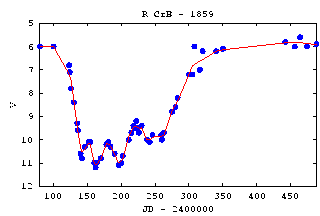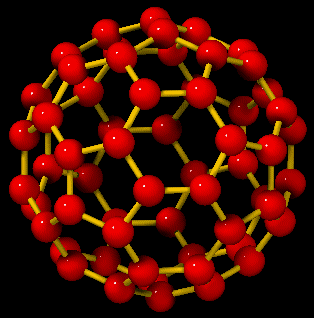


In the outermost layers of stars - especially cool stars - and in interstellar space, temperatures become very low and conditions are favourable for atoms to combine as molecules and for molecules to aggregate as grains of dust. What sorts of molecules and dust are formed in interstellar space? This dust is very important for us because eventually it is gathers together to form new stars and planets. We can learn much about the origin of our own Solar system and even life itself by studying molecules and dust in space.

From time to time, certain stars appear to dim suddenly. They can become over one hundred times fainter than normal in the course of a few days. Their light slowly returns to normal after a period of 30 to 100 days or more.
R Corona Borealis (R CrB) was the first star discovered to show this dimming in 1795. The figure shows the light curve of a typical event observed during 1859. It is part of an almost continuous series of observations obtained over the last 200 years.
The cause of the fadings is still not truly known. In the 1930's it was suggested that the dimming is due to puffs of opaque matter blown off the star in the direction of the observer. This material would be rich in carbon and might be in the form of soot, as in a smoky chimney. It must also form close to the star (less than 2 stellar radii from the surface). A major problem is that soot grains - normally graphite or amorphous carbon - cannot normally form in such a hostile environment.
 When the soccerball molecule buckminsterfullerene was discovered, it
was suggested that it might be the cause of the R CrB fadings. This is because
it is found in soot and is easily produced in a hot carbon-rich vapour, prividing
hydrogen is absent. RCrB stars are famously
deficient in hydrogen. However, so far, there is no direct evidence for the
molecule C_60 or any of its hydrides, C_60 H_n, in the spectra of R CrB stars
(Jeffery 1995).
When the soccerball molecule buckminsterfullerene was discovered, it
was suggested that it might be the cause of the R CrB fadings. This is because
it is found in soot and is easily produced in a hot carbon-rich vapour, prividing
hydrogen is absent. RCrB stars are famously
deficient in hydrogen. However, so far, there is no direct evidence for the
molecule C_60 or any of its hydrides, C_60 H_n, in the spectra of R CrB stars
(Jeffery 1995).
In July of 1996, the R CrB star V348 Sgr went through a deep minimum. This event was captured with the Hubble Space Telescope, which can measure the spectroscopic fingerprint of the obscuring material. The ultraviolet spectrum strongly resembles that of amorphous carbon, suggesting that even if C_60 is produced, it is quickly aggregated into larger carbon complexes and grains (Hecht, Clayton, Drilling & Jeffery 1998, ApJ 501, 813).

|
This page is maintained by: Simon Jeffery (csj@star.arm.ac.uk) Last modified: 08/06/00 |
The Armagh Observatory is not responsible for the content of external internet sites |